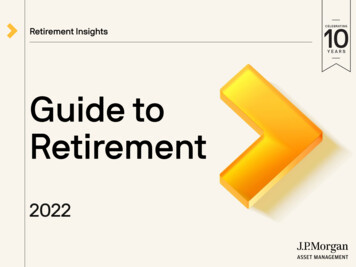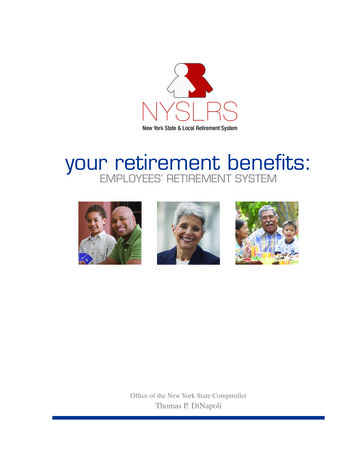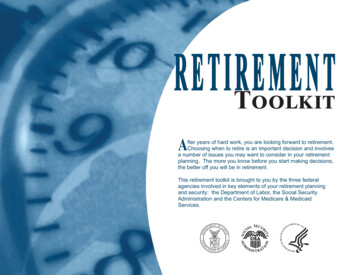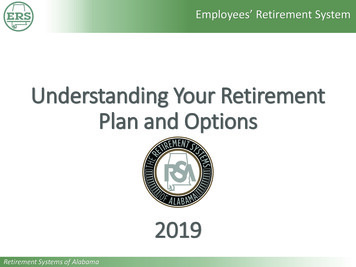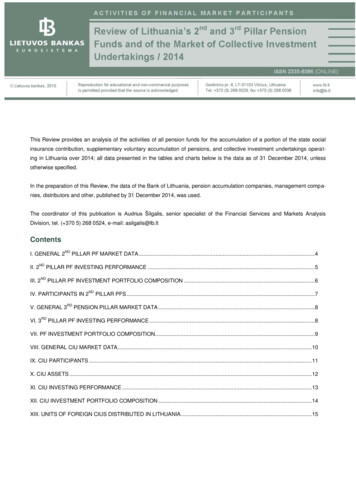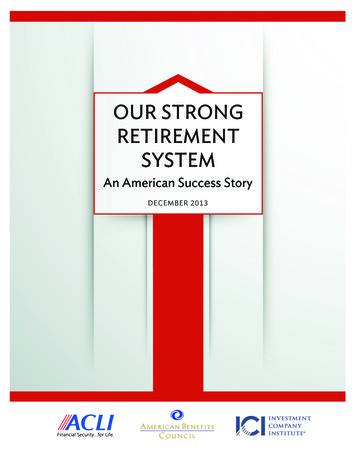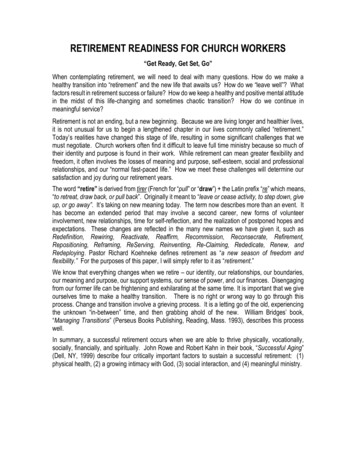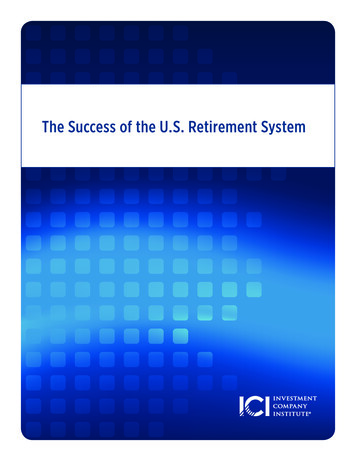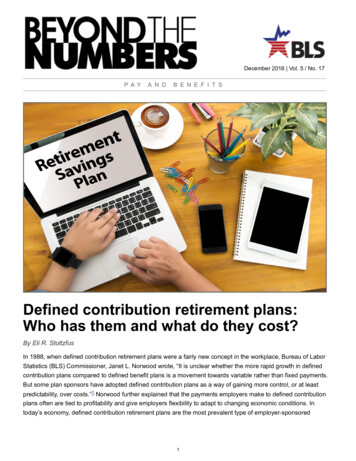
Transcription
December 2016 Vol. 5 / No. 17P A YA N DB E N E F I T SDefined contribution retirement plans:Who has them and what do they cost?By Eli R. StoltzfusIn 1988, when defined contribution retirement plans were a fairly new concept in the workplace, Bureau of LaborStatistics (BLS) Commissioner, Janet L. Norwood wrote, “It is unclear whether the more rapid growth in definedcontribution plans compared to defined benefit plans is a movement towards variable rather than fixed payments.But some plan sponsors have adopted defined contribution plans as a way of gaining more control, or at leastpredictability, over costs.”1 Norwood further explained that the payments employers make to defined contributionplans often are tied to profitability and give employers flexibility to adapt to changing economic conditions. Intoday’s economy, defined contribution retirement plans are the most prevalent type of employer-sponsored1
U.S. BUREAU OF LABOR STATISTICSretirement benefit plans in private industry in the United States. In 2016, 44 percent of private industry workersparticipated in these plans.2This Beyond the Numbers article takes a look at five types of employer-sponsored defined contribution retirementplans in private industry. The article shows the overall employee participation rates, employee participation ratesby type of plan, and overall employer costs and worker participation costs for all types of plans. All definedcontribution plans described in this article have some form of employer cost. Plans are categorized by type on thebasis of Internal Revenue Code requirements and variations in contribution methods. The data are from the BLSNational Compensation Survey (NCS) and are presented by selected worker and establishment characteristicsand geographic areas.3Saving for retirementDefined contribution retirement plans are an important component of employer-sponsored benefit packages.These plans accumulate tax-deferred savings in individual employee accounts established by the employer. Thegovernment provides tax and savings incentives to both employers and employees by making it legal to set asidemoney on a tax-deferred, salary reduction basis for retirement expenses. Businesses have incentives forcontributing money to these accounts as deferred salary because it reduces their income and payroll tax liabilities.The portion of deferred salary that workers contribute also may be exempt from income taxes, as well asinvestment income tax liabilities until the funds are withdrawn at retirement. Generally, there are no minimumamounts that an employer or employee may contribute to an account; there are, however, annual maximum limitsthat are set by the Internal Revenue Code.Defined contribution plans often provide workers with incentives to save for retirement through employer matchingcontributions, thereby encouraging workers to make active choices in their retirement planning. These plans aim toput investment decisions into the hands of workers and they provide options for investing retirement funds.However, the worker also bears an investment risk: the payout of defined contribution plans is determined by theamount of money contributed to the plan and the rate of return on the money invested over time.Defined contribution retirement plans are portable—when workers move from one job to another job they can taketheir retirement savings with them. Upon reaching retirement age, the account balance becomes available to theemployee to be used as retirement income. Savings set aside for retirement generally may not be withdrawn priorto retirement without paying a tax penalty, except in limited circumstances such as paying for college, first timehomebuyer expenses, or unexpected personal hardships.4Overall employee participationOverall employee participation rates for defined contribution plans vary significantly by some workercharacteristics. This is because many employers do not offer the benefit or, for those employers that do offer thebenefit, their employees may not want to contribute any of their salary in order to participate. Workers in highpaying jobs, for example, are more likely to participate in defined contribution plans than are workers in low-payingjobs. In 2016, 63 percent of management, professional, and related workers (relatively high-paying jobs)participated in defined contribution plans, compared with 19 percent of service workers (relatively low-paying jobs)who participated. (See chart 1.)2
U.S. BUREAU OF LABOR STATISTICSThe five types of defined contribution retirement plans reviewed in this article are: savings and thrift, deferred profitsharing, money purchase pension, employee stock ownership (ESOP), and savings incentive match plan(SIMPLE).The rate of employee participation varies by type of plan, by worker and establishment characteristics andgeographic areas. In 2015, 74 percent of all private industry workers participating in defined contribution plansparticipated in savings and thrift plans; also of note, in establishments with 1 to 99 workers, 66 percent of workersparticipated in savings and thrift plans. In establishments with 100 or more workers, 81 percent of workersparticipated in savings and thrift plans. (See table 1.) Note that table 1 shows the rate of participation in all types ofplans adds up to more than 100 percent. This is because the design of a company’s defined contribution planssometimes includes several different types of plans. For example, a savings and thrift plan may be combined witha profit-sharing plan that is aimed at fostering worker commitment to company goals.Table 1. Participation in defined contribution plans by type of plan, private industry workers, 20151CharacteristicsAll workersWorker characteristicManagement,professional, and relatedSavings and Deferred profit Money purchasethriftsharingpensionEmployee stockownership (ESOP)Savings incentivematch plan (SIMPLE)7419164373192042See footnotes at end of table.3
U.S. BUREAU OF LABOR STATISTICSTable 1. Participation in defined contribution plans by type of plan, private industry workers, 20151CharacteristicsServiceSales and officeNatural resources,construction, andmaintenanceProduction, transportation,and material movingEstablishment vidingindustries1 to 99 workers100 or more workersSavings and Deferred profit Money purchasethriftsharingpensionEmployee stockownership (ESOP)Savings incentivematch plan 226-3South8214125-Midwest721914--West742114--1 The sum of participation rates across each plan may be greater than 100 percent because multiple plans are available to some employees.2 The geographic areas correspond to census regions. For information on the states and census divisions represented by the regions, see https://www.bls.gov/regions/home.htm.Note: (All workers participating in defined contribution plans 100 percent). Dashes indicate that no data were reported or that data do not meet publicationcriteria. For definitions of major plans, key provisions, and related terms, see the "Glossary of Employee Benefit Terms" at ource: U.S. Bureau of Labor Statistics, National Compensation Survey.Savings and thrift is the most prevalent type of plan. A savings and thrift plan requires an employee to contribute apredetermined amount of earnings into an individual account, all or part of which may be matched by the employer.Usually the employer matches a portion of the employee’s contribution up to a specified percent of the employee’searnings. Both the employee and employer contributions can be either a flat amount or a percentage of theemployee’s pay, although the latter is more prevalent. NCS data show that in 2015, 62 percent of savings and thriftplan participants were in plans in which the employer matched up to a specified percentage of employee earnings.Of those plans, one-half matched up to 6 percent of employee contributions (or earnings) and the remaining halfmatched lower contribution ceilings, typically 3 percent or 4 percent of earnings.5Employees participating in savings and thrift plans often have two options for making contributions: they can maketraditional 401(k) pre-tax contributions or Roth 401(k) post-tax contributions, or both, up to Internal Revenue Codeannual limits. Traditional 401(k) pre-tax contributions, as well as any investment growth, are not subject to Federalor most State income taxes until funds are withdrawn at retirement. Roth 401(k) post-tax contributions are afeature that allows employees to make part or all of their retirement plan contributions on a post-tax basis. Upondistribution any portion of the balance that is based on pretax contributions plus earnings is taxed as regularincome; and any post-tax contributions and their earnings are not subject to income tax. NCS data show that in2015, 100 percent of savings and thrift plans had provisions that permitted employees to make pre-taxcontributions, and 50 percent of plans permitted post-tax contributions.64
U.S. BUREAU OF LABOR STATISTICSDeferred profit-sharing plans usually do not require an employee to contribute in order to participate. In theseplans, employers usually contribute fixed or discretionary amounts to employee accounts, based on the amount ofcompany profits. The contributions may be spread equally among all employees in the company or may be basedon an employee’s salary. In 2015, 19 percent of all private industry workers participating in defined contributionplans participated in deferred profit-sharing plans; also of note, in establishments with 1 to 99 workers, 21 percentof workers participated in deferred profit-sharing plans. In establishments with 100 or more workers, 17 percent ofworkers participated in deferred profit-sharing plans.A money purchase pension plan provides fixed employer contributions, typically calculated as a percentage ofemployee earnings. The contributions are allocated to individual employee accounts each year. Some plans mayallow employee contributions, but employees are not required to make contributions in order to participate.An employee stock ownership plan (ESOP) is a type of plan under which the employer pays a designated amountinto a fund that is typically invested in company-related stock. Upon retirement, the funds in the plan are distributedto employees according to a formula.A savings incentive match plan (SIMPLE) is a plan designed to help small businesses set up individual accountsfor their employees. The businesses usually have 100 or fewer employees and do not have any other qualifiedretirement plan. SIMPLE plans can be either part of a 401(k) plan or established as individual retirement accounts(IRAs).Overall employer costs and worker participation costsAlong with overall employee participation rates, and participation rates by type of plan, this article examines theoverall employer costs and worker participation costs for all types of defined contribution retirement plans.Employer costs for defined contribution plans are presented here in two ways: Costs per hour worked. This amount is averaged out among all private industry employees in the economy,even those who are not participating in a plan. Worker participation costs per hour. This amount represents the actual employer costs per hour worked onlyfor those employees who are participating in defined contribution plans.Table 2 presents employer costs per employee participating in defined contribution retirement plans by type of job,type and size of establishment, and location of establishment.Table 2. Employer costs per employee hour worked and participation in defined contribution plans, privateindustry workers, March 2016Defined contribution plansCharacteristicWages andsalaries1Employercosts1Participation rate (inpercent)2Worker participationcosts3All workers 22.33 0.7044 1.59Worker characteristicManagement, professional, andrelatedService39.021.52632.4111.390.15190.79See footnotes at end of table.5
U.S. BUREAU OF LABOR STATISTICSTable 2. Employer costs per employee hour worked and participation in defined contribution plans, privateindustry workers, March 2016Defined contribution plansCharacteristicWages andsalaries1Employercosts1Participation rate (inpercent)2Worker participationcosts3Sales and officeNatural resources, construction,and maintenanceProduction, transportation, andmaterial movingEstablishment .52441.18Goods-producing industries25.450.94531.77Service-providing industries21.700.65421.551 to 99 workers19.640.45341.32100 or more st23.430.70401.75area41 Estimates from the Employer Costs for Employee Compensation March 2016 release, see https://www.bls.gov/news.release/archives/ecec 06092016.htm.2 Estimates from the March 2016 benefits release, see .3 Worker participation cost is a derived cost that equals the employer costs per employee hour worked individual benefit cost (from Employer Costs forEmployee Compensation) divided by the individual benefit participation rate.4 The geographic areas correspond to census regions. For information on the states and census division represented by the regions, see https://www.bls.gov/regions/home.htm.Source: U.S. Bureau of Labor Statistics, National Compensation Survey.Employer costs for employee compensation typically include wages and salaries plus benefit costs. The datapresented here, the employer costs per hour worked for wages and salaries and the employer costs per hourworked for defined contribution plans, are published statistical estimates from the National Compensation Survey.The worker participation rates also are published statistical estimates.7The worker participation costs per hour worked for defined contribution plans are not published statisticalestimates. Worker participation costs are calculated by dividing the employer costs per hour for the benefitreceived by the participation rate of the benefit. The result is a derived number that represents the employer costsper hour worked for those workers participating in a plan.8 When the worker participation rate is factored in, theemployer costs per hour worked are not as low as they first appear. This is because not all workers areparticipating in a defined contribution plan, and because not all employers offer the benefit to their workers. Thus,the actual employer costs per hour worked for those employers whose employees are participating in the benefit(worker participation costs) are higher than the overall employer costs per hour. And also, the actual differences incosts (cost ratios) between different worker groups are not as great as they first appear when considering only theoverall employer costs.In March 2016, the overall employer cost for providing defined contribution benefits was 0.70 per employee hourworked in private industry. Employer costs per hour worked for defined contribution plans vary significantly bysome worker and establishment characteristics and by geographic areas. Often, the main factor determining thecosts for the plans is the wage rate that an employer pays a worker for a particular job – the contribution that the6
U.S. BUREAU OF LABOR STATISTICSemployer makes to an employee’s account often is based on a percentage of the employee’s wages. For example,wages for management, professional and related workers usually are higher than are wages for service jobs. InMarch 2016, the average employer cost per hour worked for defined contribution plans was 1.52 per hour workedfor management professional and related workers—approximately 10 times more than the 0.15 per hour workedfor service workers.Large establishments also, for example, pay a higher cost per hour worked for defined contribution plans than dosmall establishments in part because large establishments often pay higher wage rates than small establishments.In March 2016, the average employer cost per hour worked for defined contribution plans in establishments with100 or more workers was 1.01 per hour worked, compared with 0.45 per hour worked in establishments with 1to 99 workers.Worker participation costs per hour worked also vary by worker and establishment characteristic and bygeographic area, although proportionally they do not vary as much as the overall employer costs per hour worked.When using the worker participation rate to calculate the employer costs only for those workers participating indefined contribution plans, the difference in cost, or the cost ratio, between management, professional, and relatedworkers, and service workers, is not as great because now the cost is averaged out across only those workerswho are participating in a plan. For management, professional, and related workers, using the worker participationrate of 63 percent to calculate the worker participation cost shows that the employer cost is 2.41 per hour worked.For service workers, using the worker participation rate of 19 percent to calculate the worker participation costshows that the cost is 0.79 per hour worked—an approximately threefold difference in the cost ratio compared toan approximately tenfold difference in the cost ratio seen in the overall employer cost per hour worked for thesetwo groups of workers.Likewise, worker participation costs per hour worked for defined contribution plans vary when comparing costsbetween large and small establishments. When factoring in that for establishments with 100 or more workers only57 percent of workers participate in defined contribution plans, and for establishments with 1 to 99 workers only 34percent of workers participate in defined contribution plans; the worker participation cost per hour worked fordefined contribution plans for establishments with 100 or more workers is 1.77 per hour worked, only 1.3 timesmore than the 1.32 per hour worked for establishments with 1 to 99 workers.By geographic area, worker participation costs vary from 1.48 per hour in the midwest census region to 1.75 perhour in the west census region.9ConclusionDefined contribution retirement plans are the most prevalent type of employer-sponsored retirement benefit intoday’s economy. In 2016, 44 percent of private industry workers participated in these plans. Defined contributionplans provide tax and savings incentives to both employers and employees to set aside money for retirementpurposes. Employers offer different types of defined contribution plans to their employees, including savings andthrift and deferred profit-sharing plans. The most prevalent type of plan is savings and thrift—a plan that requiresan employee to make a contribution in order to receive an employer-matching contribution. To provide a furtherperspective, we examine employer costs for providing defined contribution retirement plans. In March 2016 theprivate industry overall employer cost for providing these benefits was 0.70 per employee hour worked.7
U.S. BUREAU OF LABOR STATISTICSThis Beyond the Numbers article was prepared by Eli R. Stoltzfus, economist in the Office of Field Operations, Bureau of LaborStatistics, Email: NCSInfo@bls.gov, Telephone:(202) 691-6199.Information in this article will be made available upon request to individuals with sensory impairments. Voice phone: (202) 691-5200.Federal Relay Service: 1-800-877-8339. This article is in the public domain and may be reproduced without permission.GLOSSARY401(k): The Revenue Act of 1978 included a provision that resulted in Internal Revenue Code Section 401(k) Cashand Deferred Arrangements.10 Section 401(k) created incentives for employers to provide their employees with taxdeferred compensation to be saved for retirement purposes by setting aside money on a salary reduction basis.The payments that employers contribute to these plans are tax deductible. Employees also may contribute tothese plans. For a traditional 401(k), the portion of income that employees elect to receive as deferredcompensation up to legal limits set by the IRS, rather than as direct cash payments, is exempt from income taxesuntil the funds are withdrawn at retirement.Defined benefit plan. A defined benefit retirement plan provides employees with guaranteed retirement benefitsthat are based on a benefit formula. A participant’s retirement age, length of service, and pre-retirement earningsmay affect the benefit received. In the private sector, defined benefit plans are typically funded exclusively byemployer contributions.Defined contribution plan. A defined contribution retirement plan specifies the level of employer and employeecontributions (retirement savings) and places those contributions into individual employee accounts. Retirementbenefits are based on the level of contributions, plus earnings, that have accumulated in the account at the time ofretirement.Employer matching contribution. The employer matches a specified percentage of employee contributions. Thematching percentage can vary by length of service, amount of employee contribution, or other factors.Individual retirement accounts (IRAs). An IRA is a retirement savings plan. There are several types of IRAs:traditional IRAs, Roth IRAs, savings incentive match plans for employees (SIMPLE) IRAs, and simplified employeepension (SEP) IRAs. Traditional and Roth IRAs are established by individuals who are allowed to contributeearnings up to a set maximum dollar amount. SIMPLE and SEPs plans are retirement plans established byemployers.Participation. Participation is the percentage of employees who actually enroll in an employer-sponsored benefitplan, such as a health benefit plan or a retirement benefit plan. A plan may be a contributory plan, which requiresemployees to contribute to the plan’s cost, or a noncontributory plan, in which the employer pays 100 percent ofthe cost of the benefit.NOTES1Janet L. Norwood, “Measuring the cost and incidence of employee benefits,” Monthly Labor Review, (August 1988), pp. 3–8, https://www.bls.gov/opub/mlr/1988/08/art1full.pdf. The declining incidence over the last few decades of defined benefit pension plans inprivate industry is well documented. See also, William J. Wiatrowski, “Changing landscape of employment-based retirement benefits,”8
U.S. BUREAU OF LABOR STATISTICSMonthly Labor Review, (September 2011), e-of-employment-based-retirementbenefits.pdf and, “The last private industry pension plans: a visual essay,” Monthly Labor Review, (December 2012), pp. 3–18, 2Employee Benefits in the United States, March 2016, Bulletin 2785, table 2 (U.S. Bureau of Labor Statistics, September ership/private/table02a.htm.3Health and Retirement Plan Provisions in Private Industry in the United States 2015, Bulletin 2784, table 54 (U.S. Bureau of LaborStatistics, April 2016) 5/ownership/private/table54a.pdf and, Employer Costs forEmployee Compensation – March 2016, USDL-16-1150 (U.S. Bureau of Labor Statistics, June 9, 2016), https://www.bls.gov/news.release/archives/ecec 06092016.htm.4Retirement Topics - Exceptions to Tax on Early Distributions (Internal Revenue Service) butions and www.irs.gov/taxtopics/tc558.html.5Health and Retirement Plan Provisions in Private Industry in the United States 2015, Bulletin 2784, table 60 (U.S. Bureau of LaborStatistics, April 2016) 5/ownership/private/table60a.pdf.6Ibid., table 57, 5/ownership/private/table57a.pdf.7Employer Costs for Employee Compensation – March 2016, USDL-16-1150 (U.S. Bureau of Labor Statistics, June 9, 2016) https://www.bls.gov/news.release/archives/ecec 06092016.pdf and, Employee Benefits in the United States, March 2016, Bulletin 2785(U.S. Bureau of Labor Statistics, September 2016) .pdf.8Thomas G. Moehrle, John L. Bishow, and Anthony J. Barkume, “Benefit cost concepts and the limitations of ECEC measurement,”Monthly Labor Review, (July 2012), te: Statistical comparison statements involving estimates of worker participation costs cannot be validated due to unavailablestandard error estimates.9Geographic Terms and Concepts - Census Divisions and Census Regions, (Census Bureau), ference/us regdiv.pdf10The Revenue Act of 1978, 26 U.S.C. § 401(k) (1978), Cash and Deferred Arrangements, ESTEDCITATIONEli R. Stoltzfus, “Defined contribution retirement plans: Who has them and what do they cost?” Beyond the Numbers: Pay andBenefits, vol. 5, no. 17 (U.S. Bureau of Labor Statistics, December 2016), they-cost.htm9
In 1988, when defined contribution retirement plans were a fairly new concept in the workplace, Bureau of Labor Statistics (BLS) Commissioner, Janet L. Norwood wrote, "It is unclear whether the more rapid growth in defined contribution plans compared to defined benefit plans is a movement towards variable rather than fixed payments.
